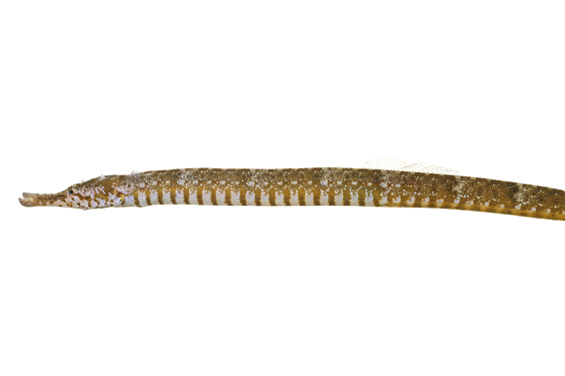Ladder Pipefish, Festucalex scalaris (Günther 1870)

Ladder Pipefish, Festucalex scalaris. Source: Barry Hutchins / Western Australian Museum. License: CC BY Attribution-Noncommercial-ShareAlike
This endemic Western Australian species is known mostly from specimens that have been collected in trawls.
Ladder Pipefish, Festucalex scalaris (Günther 1870)
More Info
|
Distribution |
Endemic to subtropical waters of Western Australia; inhabits intertidal algae or sargassum beds to 20 m. |
|
Features |
Meristic features: Dorsal fin 24-26; Pectoral fin 11-13;Trunk rings 18-20; Tail rings 37-40. Snout short, length 2.1-2.5 in head length; lateral snout ridge obsolete, postorbital ridge low. Lateral trunk ridge crosses 1-3 tail rings; ridges of last 1-2 tail rings not modified; small dermal flaps usually present on head but absent or sparse on body; dermal flaps absent from trunk and tail in subadults and adults. Pectoral fin base rounded and somewhat protruding laterally, without ridges in adults. |
|
Size |
To 200 mm TL |
|
Colour |
Snout light tan above, remainder of head mainly tan to light brown; lower half of snout, suborbital, opercle and ventral surface of head with irregular scattering of small brown spots; dorsal surface and sides of body with 13-14 indistinct brownish bars between head and caudal fin base; bars separated by narrower pale interspaces which may be plain, blotched or with fine brown reticulations; caudal fin brownish with pale spots or blotches. |
|
Feeding |
Unknown - likely to feed on small crustaceans. |
|
Biology |
Males brood the developing eggs in a semi-exposed pouch under the trunk. The pouch folds fall well short of the midline of the egg-filled pouch. Males may begin brooding at 120 mm SL. The eggs are in a single, two row layer in the pouch. |
|
Fisheries |
|
|
Conservation |
Marine listed under the Environment Protection and Biodiversity Conservation Act 1999. |
|
Remarks |
Most specimens have been collected in bottom trawls. |
|
Similar Species |
F. scalaris can be distinguished from other members of the genus Festucalex by a combination of high trunk ring counts (18-20 versus 18 or less), high total ring counts (56-59 versus 56 or less), and in having a spotted head and barred ventral surface and the absence of modified posterior tail rings. F. scalaris is most similar to F. cinctus in counts, differing in colouration, some proportional characters and in lacking the modified tail rings of F. cinctus. |
|
Etymology |
Festucalex is from the Latin, festuca meaning "stalk, straw coloured". The specific name is from the Latin scalar meaning "resembling a ladder". |
|
Species Citation |
Ichthyocampus scalaris Günther 1870, Cat. Fishes 8: 177, Freycinet's Harbour, Australia. |
|
Author |
Thompson, Vanessa J. & Dianne J. Bray |
Ladder Pipefish, Festucalex scalaris (Günther 1870)
References
Allen, G.R. 1997. Marine fishes of tropical Australia and south-east Asia. Western Australian Museum, Perth. 292 pp.
Allen, G.R. & R. Swainston. 1988. The marine fishes of north-western Australia. A field guide for anglers and divers. Western Australian Museum, Perth. 201 pp.
Dawson, C.E. 1977. Synopsis of Syngnathine pipefishes usually referred to the genus Ichthyocampus Kaup, with description of new genera and species. Bull. Mar. Sci. 27(4): 595-650
Dawson, C.E. 1985. Indo-Pacific Pipefishes (Red Sea to the Americas). Gulf Coast Research Laboratory, Ocean Springs, Mississippi. 230 pp.
Günther, A. 1870. Catalogue of the Fishes in the British Museum. Vol. 8. British Museum, London. 549 pp.
Hoese, D.F., D.J. Bray, J.R. Paxton & G.R. Allen. 2006. Fishes. In Beesley, P.L. & A. Wells (eds). Zoological catalogue of Australia. Volume 35. ABRS & CSIRO Publishing: Australia. 2178 pp.
IUCN. (2007). 2007 IUCN Red List of Threatened Species. http://www.iucnredlist.org
Kuiter, R.H. 2000. Seahorses, Pipefishes and their Relatives. TMC Publishing, Chorleywood, UK. 240 pp.
Pogonoski, J.J., D.A. Pollard & J.R. Paxton. 2002. Conservation Overview and Action Plan for Australian Threatened and Potentially Threatened Marine and Estuarine Fishes, Environment Australia, Canberra. 375 pp.

